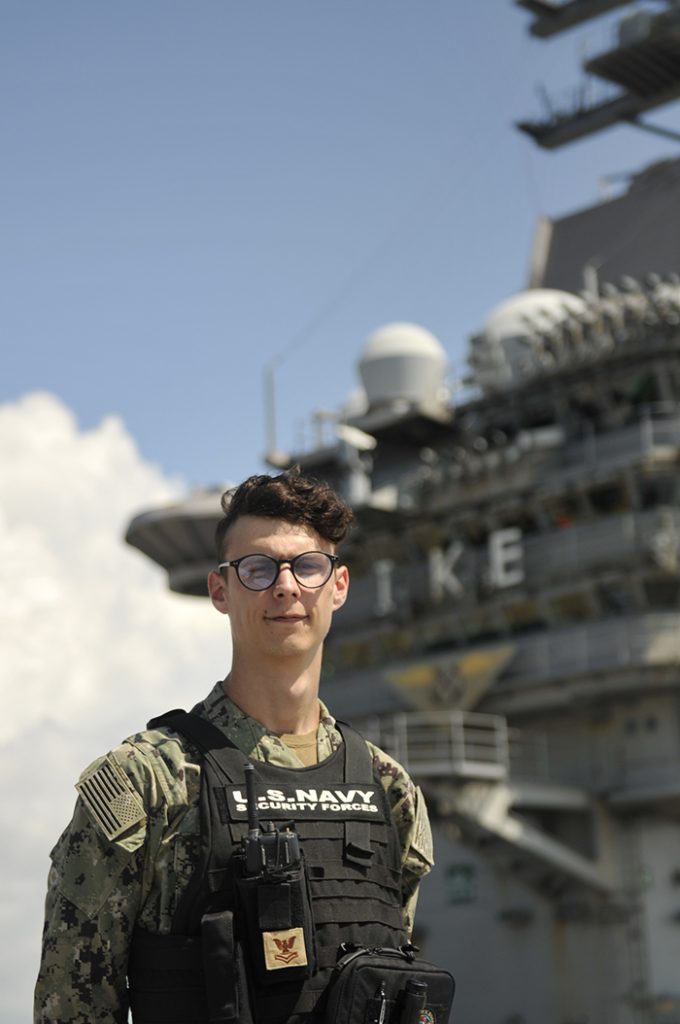Perham native serves aboard U.S. Navy floating airport
News | Published on October 18, 2023 at 11:07am EDT | Author: frazeevergas
0Weis is serving on USS Dwight D. Eisenhower

Petty Officer 2nd Class Travis Weis is serving on the USS Dwight D. Eisenhower.
By Alvin Plexico
Navy Office of Community Outreach
Petty Officer 2nd Class Travis Weis, a native of Perham, is one of more than 5,000 sailors serving aboard the self-contained mobile airport, USS Dwight D. Eisenhower.
Weis graduated in 2017 from Perham High School.
The skills and values needed to succeed in the Navy are similar to those found in Perham.
“Hard work is just work,” said Weis. “This is something my family says, which means that it doesn’t matter what work you’re doing. Always do a good job and when it’s over, you’ll have something to be proud of.”
Weis joined the Navy three years ago. Today, Weis serves as a master-at-arms.
“I joined the Navy because I wanted to make a difference,” said Weis.
Aircraft carriers are the centerpiece of America’s Naval forces. For more than 100 years, they have projected power, sustained sea control, bolstered deterrence, provided humanitarian assistance and disaster relief, and maintained enduring commitments worldwide.
According to Navy officials, aircraft carriers are versatile and have unique mission capabilities that make them a more strategic asset for the Navy than fixed-site bases. They are often the first response in a global crisis because of their ability to operate freely in international waters anywhere in the world. In addition, no other weapon system can deploy and operate forward with a full-sized, nuclear-powered aircraft carrier’s speed, endurance, agility and the combat capability of its air wing.
“Mighty IKE” is a nuclear-powered aircraft carrier named for Dwight D. Eisenhower, one of only four five-star U.S. Army generals and a hero of World War II who would later serve as the 34th president of the United States. Homeported in Norfolk, Virginia, the carrier is longer than three football fields at 1,092 feet. The ship is 252 feet wide and weighs more than 100,000 tons.
This year commemorates 50 years of women flying in the U.S. Navy. In 1973, the first eight women began flight school in Pensacola, Florida. Six of them, known as “The First Six,” earned their “Wings of Gold” one year later. Over the past 50 years, the Navy has expanded its roles for women to lead and serve globally, and today women aviators project power from the sea in every type of Navy, Marine Corps and Coast Guard aircraft. According to Navy officials, our nation and our Navy are stronger because of their service.
Serving in the Navy means Weis is part of a team that is taking on new importance in America’s focus on rebuilding military readiness, strengthening alliances and reforming business practices in support of the National Defense Strategy.
“The Navy provides for national security by providing safe and free travel and trade on the seas,” said Weis.
With 90% of global commerce traveling by sea and access to the internet relying on the security of undersea fiber optic cables, Navy officials continue to emphasize that the prosperity of the United States is directly linked to trained sailors and a strong Navy.
Weis has many opportunities to achieve accomplishments during military service.
“I was meritoriously advanced to my current rank of E-5,” said Weis. “This advancement validated that all the work I did was worth it.”
As Weis and other sailors continue to train and perform missions, they take pride in serving their country in the U.S. Navy.
“Serving in the Navy is about making sure everyone goes home at the end of the day,” said Weis.
Weis is grateful to others for helping make a Navy career possible.
“I’d like to send a shoutout to my younger cousins, Jacob, Garrison, Kaia, and Mitch,” added Weis. “Mitch and Jacob are in the Air Force, Garrison is in the Marine Corps and Kaia is a corpsman in the Navy. Jacob joined first. Garrison and I decided to join together.”

